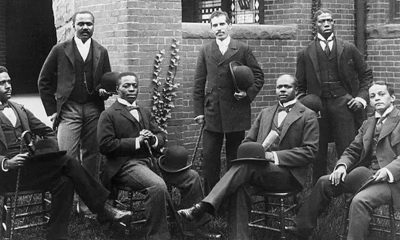National
Blacks Underrepresented in STEM Classes

Wade Henderson, president and CEO of the Leadership Conference on Civil and Human Rights talks about the 2014 Voting Rights Amendment Act at a press conference on Capitol Hill. (Freddie Allen/NNPA)
By Freddie Allen
NNPA Senior Washington Correspondent
WASHINGTON (NNPA) – Many young African Americans will be shut out of the high paying jobs of the future, if they don’t earn a degree in the science, technology, engineering and mathematics (STEM), according to a new report.
The new report by The Leadership Conference on Civil and Human Rights, a coalition of more than 200 advocacy and outreach groups, said that less than 3 percent of Blacks have earned a degree in the natural sciences or engineering fields by the age of 24 and that the STEM labor force is projected to grow by 2.6 million jobs over the next five years. Researchers said that more than half of those jobs will go to people with bachelor’s or master’s degrees.
In a press release about the report Wade Henderson, president and CEO of both the Leadership Conference on Civil and Human Rights and the Leadership Conference Education Fund, said that equal access to a STEM education is crucial to the future of our country and economy, and to the lives of millions of minority and women students.
“We must – all of us – examine what systemic changes are necessary to ensuring that STEM learning is inclusive, engaging, and equally accessible, so that all of our children have the same opportunities to adequately prepare for college and for careers that will allow them to support themselves and their families,” said Henderson.
According the U.S. Bureau of Labor Statistics, STEM workers, specifically in computer and math careers, make more than $80,000 per year. Even workers that graduate with associate’s degrees earn about 10 percent more than those working in non-STEM jobs.
“Yet, right now, all across America, there are nearly 40 million adults – disproportionately people of color and those who grew up in poverty – who do not have a high school diploma or its equivalent,” stated the report. “And they are effectively locked into the lowest rungs of the occupational ladder.”
The majority of poor children don’t know enough words or have enough math skills when they start kindergarten and confronted with less experienced teachers and limited resources are ill-equipped for Algebra, a prerequisite for higher-level math courses, by the time they reach the 8th grade.
Some states failed to provide minority students access to those high-level math and English courses altogether.
“In 2013, there were 11 states where not one Black student took the Advanced Placement (AP) computer science exam, which allows high school students to earn college credit: Alaska, Idaho, Kansas, Maine, Mississippi, Montana, Nebraska, New Mexico, North Dakota, Utah, and Wyoming,” stated the report. “Nearly 20 percent of African-American high school students attend a high school that does not offer any AP courses.”
The report included a number of policy proposals and necessary actions for federal, state, and local lawmakers as well the private sector and philanthropic groups designed to encourage diversity in STEM careers and to raise the awareness of opportunities in STEM in the Black community. Those proposals included provided access to STEM courses as early as elementary school, investing more resources into training teachers, developing technical job programs for an evolving workforce, and asking business and industry leaders to collaborate with colleges to make sure that students are gaining skills to fill vacant STEM jobs.
The report noted that, “The President’s Council of Advisors on Science and Technology (PCAST) warned that 300,000 or so college students graduating each year with bachelor’s and associate’s degrees in STEM fields is one million off the mark
The Department of Education launched The Equity and Excellence Commission, in an effort to eliminate the racial and socioeconomic disparities in education. That group recommended ensuring high-quality early learning programs for low-income students, distributing highly effective teachers equitably, incentivizing the development of racially and socioeconomically diverse schools, and strengthening parent engagement programs.
The Leadership Conference report said that it’s time for the United States to the examine the pressures that squeeze minority children out of the STEM pipeline and to accelerate the reforms that work to close the opportunity and achievement gaps.
“STEM education isn’t merely a new feel-good fad,” stated the report. “It is now – and will continue to be – the backbone of our dynamic and constantly changing world. And it’s critical that we make sure that it’s equally available to every child.”
###
Activism
Ann Lowe: The Quiet Genius of American Couture
Lowe was born in Clayton, Alabama, into a family of gifted seamstresses. Her mother and grandmother were well-known dressmakers who created exquisite gowns for women in the area. By the time Lowe was a young girl, she was already showing extraordinary talent — cutting, sewing, and decorating fabric with a skill that far exceeded her age. When her mother died unexpectedly, Lowe – only 16 years old then – took over her mother’s sewing business, completing all the orders herself.

By Tamara Shiloh
Ann Cole Lowe, born Dec.14, 1898, was a pioneering American fashion designer whose extraordinary talent shaped some of the most widely recognized and celebrated gowns in U.S. history.
Although she designed dresses for society’s wealthiest families and created masterpieces worn at historic events, Lowe spent much of her life in the shadows — uncredited, underpaid, yet unmatched in skill. Today, she is celebrated as one of the first nationally recognized African American fashion designers and a true visionary in American couture.
Lowe was born in Clayton, Alabama, into a family of gifted seamstresses. Her mother and grandmother were well-known dressmakers who created exquisite gowns for women in the area. By the time Lowe was a young girl, she was already showing extraordinary talent — cutting, sewing, and decorating fabric with a skill that far exceeded her age. When her mother died unexpectedly, Lowe – only 16 years old then – took over her mother’s sewing business, completing all the orders herself. This early responsibility would prepare her for a lifetime of professional excellence.
In 1917, Lowe moved to New York City to study at the S.T. Taylor Design School. Although she was segregated from White students and forced to work separately, she, of course, excelled, graduating earlier than expected. Her instructors quickly recognized that her abilities were far above the typical student, especially her skill in hand-sewing, applique, and intricate floral embellishment – techniques that would become her signature.
Throughout the 1920s and 1930s, she designed gowns for high-society women in Florida and New York, operating boutiques and working for prestigious department stores. Her reputation for craftsmanship, originality, and elegance grew increasingly. She was known for creating gowns that moved beautifully, featured delicate hand-made flowers, and looked sculpted rather than sewn. Many wealthy clients specifically requested “an Ann Lowe gown” for weddings, balls, and galas.
Her most famous creation came in 1953: the wedding gown worn by Jacqueline Bouvier when she married Massachusetts Sen. John F. Kennedy. The dress – crafted from ivory silk taffeta with dozens of tiny, pleated rosettes – became one of the most photographed bridal gowns in American history. Despite this achievement, Lowe received no public credit at the time. When a flood destroyed her completed gowns 10 days before the wedding, she and her seamstresses worked day and night to remake everything – at her own expense. Her dedication and perfectionism never wavered.
She eventually opened “Ann Lowe Originals,” her own salon on New York’s Madison Avenue. She served clients such as the Rockefellers, DuPonts, Vanderbilts, and actresses like Olivia de Havilland. Yet even with her wealthy clientele, she struggled financially, often undercharging because she wanted every dress to be perfect, even if it meant losing money.
Lowe’s contributions were finally recognized later in life. Today, her exquisite gowns are preserved in museums, including the Smithsonian National Museum of African American History and Culture and the Metropolitan Museum of Art.
In the last five years of her life, Lowe lived with her daughter Ruth in Queens, N.Y. She died at her daughter’s home on Feb. 25, 1981, at the age of 82, after an extended illness.
Activism
Oakland Post: Week of December 10 – 16, 2025
The printed Weekly Edition of the Oakland Post: Week of – December 10 – 16, 2025

To enlarge your view of this issue, use the slider, magnifying glass icon or full page icon in the lower right corner of the browser window.
Alameda County
Seth Curry Makes Impressive Debut with the Golden State Warriors
Seth looked comfortable in his new uniform, seamlessly fitting into the Warriors’ offensive and defensive system. He finished the night with an impressive 14 points, becoming one of the team’s top scorers for the game. Seth’s points came in a variety of ways – floaters, spot-up three-pointers, mid-range jumpers, and a handful of aggressive drives that kept the Oklahoma City Thunder defense on its heels.

By Y’Anad Burrell
Tuesday night was anything but ordinary for fans in San Francisco as Seth Curry made his highly anticipated debut as a new member of the Golden State Warriors. Seth didn’t disappoint, delivering a performance that not only showcased his scoring ability but also demonstrated his added value to the team.
At 35, the 12-year NBA veteran on Monday signed a contract to play with the Warriors for the rest of the season.
Seth looked comfortable in his new uniform, seamlessly fitting into the Warriors’ offensive and defensive system. He finished the night with an impressive 14 points, becoming one of the team’s top scorers for the game. Seth’s points came in a variety of ways – floaters, spot-up three-pointers, mid-range jumpers, and a handful of aggressive drives that kept the Oklahoma City Thunder defense on its heels.
One of the most memorable moments of the evening came before Seth even scored his first points. As he checked into the game, the Chase Center erupted into applause, with fans rising to their feet to give the newest Warrior a standing ovation.
The crowd’s reaction was a testament not only to Seth’s reputation as a sharpshooter but also to the excitement he brings to the Warriors. It was clear that fans quickly embraced Seth as one of their own, eager to see what he could bring to the team’s championship aspirations.
Warriors’ superstar Steph Curry – Seth’s brother – did not play due to an injury. One could only imagine what it would be like if the Curry brothers were on the court together. Magic in the making.
Seth’s debut proved to be a turning point for the Warriors. Not only did he contribute on the scoreboard, but he also brought a sense of confidence and composure to the floor.
While their loss last night, OKC 124 – GSW 112, Seth’s impact was a game-changer and there’s more yet to come. Beyond statistics, it was clear that Seth’s presence elevated the team’s performance, giving the Warriors a new force as they look to make a deep playoff run.
-

 Activism4 weeks ago
Activism4 weeks agoIN MEMORIAM: William ‘Bill’ Patterson, 94
-

 Activism4 weeks ago
Activism4 weeks agoOakland Post: Week of November 19 – 25, 2025
-

 #NNPA BlackPress4 weeks ago
#NNPA BlackPress4 weeks agoBeyoncé and Jay-Z make rare public appearance with Lewis Hamilton at Las Vegas Grand Prix
-

 #NNPA BlackPress2 weeks ago
#NNPA BlackPress2 weeks agoLIHEAP Funds Released After Weeks of Delay as States and the District Rush to Protect Households from the Cold
-

 #NNPA BlackPress4 weeks ago
#NNPA BlackPress4 weeks agoLewis Hamilton set to start LAST in Saturday Night’s Las Vegas Grand Prix
-

 Alameda County2 weeks ago
Alameda County2 weeks agoSeth Curry Makes Impressive Debut with the Golden State Warriors
-

 Activism3 weeks ago
Activism3 weeks agoOakland Post: Week of November 26 – December 2, 2025
-

 #NNPA BlackPress3 weeks ago
#NNPA BlackPress3 weeks agoSeven Steps to Help Your Child Build Meaningful Connections




















































